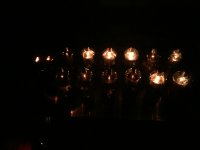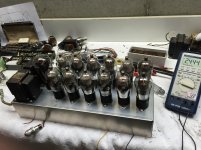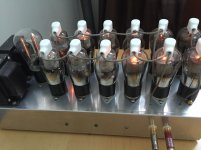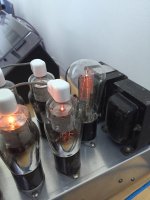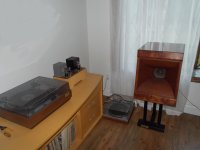24A "power" amp sounds great
Hi,
I used mostly salvage parts. The globe 24a lights brighter and sounds better I think. The amp is super quiet with no hum. I used all cloth wire and old solid copper wire for most of the wiring.
Here's at trick....most of you will agree that mesh-plate rectifiers sound better...right? So you also know that the 380 or similar globe rectifier with mesh plates are rare and expensive. So....
Purchase AZ-11 which are pretty cheap and re-base them! Since the AZ-11 is 4 volt filament, hide a 1 ohm resistor in the base, good for 2 watts. It works great! This is shown in the photos.
The speakers are WE755 in a sealed back, tractrix horn. Not the most efficient speaker but still awesome. The amp in that picture is the Morrison Micro 2A3 but not very micro at 50 lbs... I ran the two speakers in mono for quite a while before the 24A made it to prime time. This 24A is the version with no screen supply, strapped screen to plate. Also no feedback. The output iron is salvage 5K outputs from an old AKAI Roberts reel-to-reel that ran SE EL-84. They work fine for 1 Watt and are under the chassis.
Thanks for a fun project!
Have fun!
Hi,
I used mostly salvage parts. The globe 24a lights brighter and sounds better I think. The amp is super quiet with no hum. I used all cloth wire and old solid copper wire for most of the wiring.
Here's at trick....most of you will agree that mesh-plate rectifiers sound better...right? So you also know that the 380 or similar globe rectifier with mesh plates are rare and expensive. So....
Purchase AZ-11 which are pretty cheap and re-base them! Since the AZ-11 is 4 volt filament, hide a 1 ohm resistor in the base, good for 2 watts. It works great! This is shown in the photos.
The speakers are WE755 in a sealed back, tractrix horn. Not the most efficient speaker but still awesome. The amp in that picture is the Morrison Micro 2A3 but not very micro at 50 lbs... I ran the two speakers in mono for quite a while before the 24A made it to prime time. This 24A is the version with no screen supply, strapped screen to plate. Also no feedback. The output iron is salvage 5K outputs from an old AKAI Roberts reel-to-reel that ran SE EL-84. They work fine for 1 Watt and are under the chassis.
Thanks for a fun project!
Have fun!
Attachments
I forgot to elaborate on the sound of the 24A massive parallel amp.
The sound is really lush with a lot of inner detail. You need sensitive speakers for sure.
I play jazz LPs through an ARC SP-9 preamp, mostly. My theory is that the more plate area you spread the electrons over, the better detail and richer sound. The best part is that there is no hum at all; the great part about heater cathode tubes. Older globe 224 warm up slower and give off more light and I think they sound best but there is nothing wrong with the later ST types. It is best to scrape the pins of the tubes really clean with a razor blade to get the best contact and also re-flow the solder in the pins- a little flux doesn't hurt. The great sound would be great to have with a few more watts.
The sound is really lush with a lot of inner detail. You need sensitive speakers for sure.
I play jazz LPs through an ARC SP-9 preamp, mostly. My theory is that the more plate area you spread the electrons over, the better detail and richer sound. The best part is that there is no hum at all; the great part about heater cathode tubes. Older globe 224 warm up slower and give off more light and I think they sound best but there is nothing wrong with the later ST types. It is best to scrape the pins of the tubes really clean with a razor blade to get the best contact and also re-flow the solder in the pins- a little flux doesn't hurt. The great sound would be great to have with a few more watts.
Hello,
I have been hooked on SE45 for a long time. Better than 2A3, even mono plate. Super Rare 2A3H is probably more similar to the 24A amp. The 24A amp has super lush midrange, lots of harmonic content. Super quiet background. I used salvage output transformers so better ones would add to the fund. I used the Russian oil caps to couple with, not plastic, also I used 100 year old solid copper wire for internal wiring. Age on copper adds magic to the sound. Choke loaded tube rectifier is a must also. I decoupled each side with 100uF caps salvaged from switching power supplies.
I have been hooked on SE45 for a long time. Better than 2A3, even mono plate. Super Rare 2A3H is probably more similar to the 24A amp. The 24A amp has super lush midrange, lots of harmonic content. Super quiet background. I used salvage output transformers so better ones would add to the fund. I used the Russian oil caps to couple with, not plastic, also I used 100 year old solid copper wire for internal wiring. Age on copper adds magic to the sound. Choke loaded tube rectifier is a must also. I decoupled each side with 100uF caps salvaged from switching power supplies.
Attachments
Power Supply Info
This amp uses three transformers- two 2.5 v @ 10 amps and another that has normal B voltages and I use the filament outputs for the rectifier (5v) and pilot lamp (6.3v)
The B+ comes from one leg of the rectifier filament. I run this into a choke which also has some resistance. Then the B+ is sent to the plates, decoupled by 100uF for each side. When the 24As begin to conduct and load the power supply, it should settle at the voltage I got, shown in one of the pictures. If your voltage is low for the transformer you are using, one way to get a boost is to add small value caps at the rectifier output. 0.5uF to 2.0 uF seem to add 20-40 volts DC to the supply. I save small oil caps for this purpose. Remember, you have to connect the center tap of the transformer secondary to the ground bus and I connect the ground bus wire to the input RCA jack bodies.If you are using salvage stuff, look for power transformers with the copper strap around them, they will be quieter, emitting less noise. Twist all the filament wires and cram them into the corners of the chassis.
This amp uses three transformers- two 2.5 v @ 10 amps and another that has normal B voltages and I use the filament outputs for the rectifier (5v) and pilot lamp (6.3v)
The B+ comes from one leg of the rectifier filament. I run this into a choke which also has some resistance. Then the B+ is sent to the plates, decoupled by 100uF for each side. When the 24As begin to conduct and load the power supply, it should settle at the voltage I got, shown in one of the pictures. If your voltage is low for the transformer you are using, one way to get a boost is to add small value caps at the rectifier output. 0.5uF to 2.0 uF seem to add 20-40 volts DC to the supply. I save small oil caps for this purpose. Remember, you have to connect the center tap of the transformer secondary to the ground bus and I connect the ground bus wire to the input RCA jack bodies.If you are using salvage stuff, look for power transformers with the copper strap around them, they will be quieter, emitting less noise. Twist all the filament wires and cram them into the corners of the chassis.
This amp uses three transformers- two 2.5 v @ 10 amps and another that has normal B voltages and I use the filament outputs for the rectifier (5v) and pilot lamp (6.3v) <snip>
It's been two years I'm thinking of building one... do you think I can wire all the filaments in series and use a more common 30v 4A transformer? I would save lot of money...
- Status
- This old topic is closed. If you want to reopen this topic, contact a moderator using the "Report Post" button.
- Home
- Amplifiers
- Tubes / Valves
- could 24A been power tube
